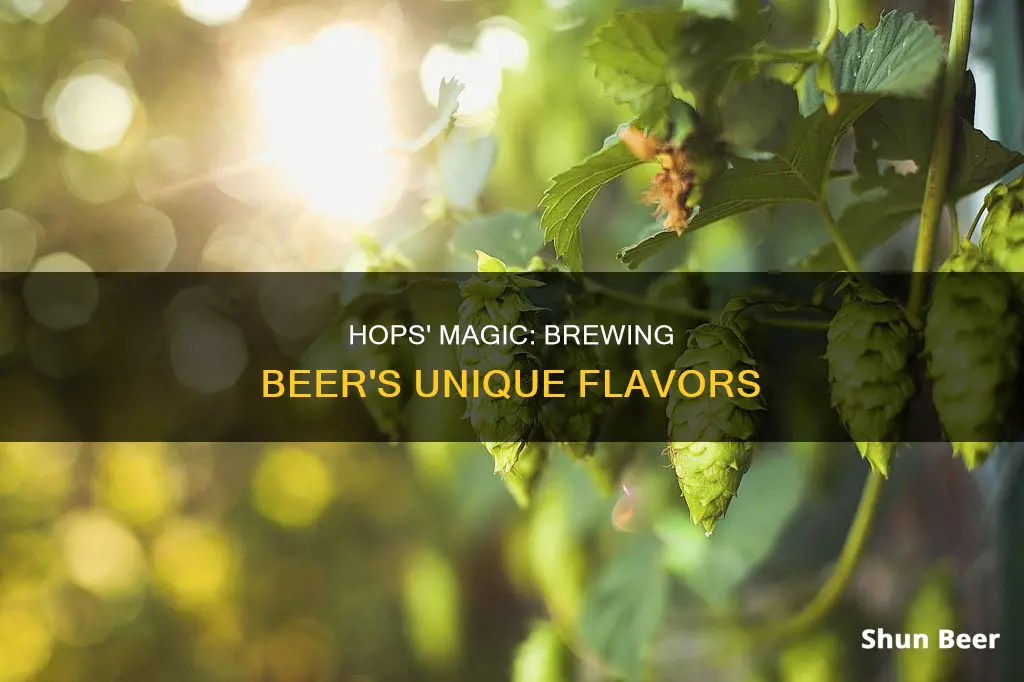
Hops are the cone-shaped flowers of the female hops plant, Humulus lupulus, a cousin of the cannabis plant. They are one of the essential ingredients in beer, alongside barley, yeast, and water. Hops contribute bitterness, flavour, and aroma to beer, and also act as a preservative. The alpha and beta acids in hops are responsible for the bittering of the beer, while the beta acids also help to counteract and delay the effects of bacterial spoilage, giving beer a longer shelf life. Hops also contain oils that add to the flavour of the beer. The timing of when hops are added during the brewing process will affect the flavour and bitterness of the beer.
| Characteristics | Values |
|---|---|
| Hop type | Cone-shaped flowers of the female hops plant |
| Hop plant name | Humulus lupulus |
| Hop plant family | Cannabis |
| Hop ingredients | Acids and oils |
| Hop function | Impart bitterness, flavour, and stability to the finished beer |
| Hop addition stage | Boil stage of brewing |
| Hop quantity | Varies depending on style and region |
| Hop preservation | Natural preservative that inhibits spoilage bacteria and increases shelf life |
| Hop measurement | IBU (International Bittering Units) |
What You'll Learn

Hops balance the sweet malt flavour of beer
Hops are an essential ingredient in beer, adding bitterness to balance the sweetness of malt. They are the cone-shaped flowers of the female hops plant, Humulus lupulus, a cousin of the cannabis plant. Hops contain alpha acids, which are responsible for the bitter flavour in beer. However, these alpha acids must be chemically altered through boiling to be utilised in beer. Therefore, hops are typically added during the boil stage of brewing, with a longer boiling time resulting in more bitterness.
The role of hops in beer is not limited to bitterness. They also contribute flavour and aroma, with a range of varieties and growing regions producing distinct characteristics. For example, hops can impart flavours and aromas ranging from citrus and pine to earthy and spicy notes. The addition of hops at different stages of the brewing process can enhance these characteristics. While hops added at the beginning of the boil contribute bitterness, those added towards the end add more flavour and aroma.
The choice and timing of hops can vary depending on the style of beer being brewed and the desired flavour profile. In some beers, hops may take a supporting role, providing structural support while other flavours are emphasised. Additionally, hops act as a preservative, inhibiting spoilage bacteria and stabilising the foam of the beer.
The interplay between hops and malt creates a delicate balance in beer. While hops bring bitterness, malt provides sweetness and a range of flavours, such as bread, biscuit, toast, nutty toffee, caramel, coffee, and chocolate. The specific types of malt used and the kilning process can also influence the flavour profile. Thus, the combination of hops and malt, along with other ingredients and brewing techniques, creates the complex and varied flavours found in different beers.
Hop Butcher's Lactose: A Universal Addition?
You may want to see also

Hops add flavour and aroma to beer
Hops are the cone-shaped flowers of the female hops plant, also known as Humulus lupulus. They are one of the essential ingredients in beer, alongside barley, yeast, and water. Hops add flavour and aroma to beer, as well as providing bitterness to balance the sweetness of the malt.
The unique flavours and aromas of hops come from the resins and oils inside the lupulin glands of the hop cones. The timing of when hops are added during the brewing process will affect the flavour and aroma of the beer. Hops are typically added to the wort in three stages during the boil: bittering, flavour, and aroma. However, some beers may have only one addition, while others may have up to five or six. All beers will have at least one addition of hops for bitterness.
The same hop variety can be used for bittering, flavouring, and aroma. For example, Cascade hops can be used for bittering, flavouring, or aroma. However, the time at which they are added to the boil will make the difference. When added at the beginning of the boil, they contribute more bitterness, while adding them at the end of the boil enhances the aroma and flavour.
The variety of hops used also makes a difference. For instance, Pilsner beers are often associated with the four "noble hops" varieties: Tettnanger, Spalt, Hallertauer, and Saaz. On the other hand, the English Golding hop is the signature hop of English ale, while the Fuggle hop is another popular choice for ale. American hops are known for their bold and intense flavours and are often described as citrus-like.
In addition to flavour and aroma, hops also act as a preservative, inhibiting spoilage bacteria and giving beer a longer shelf life. They also help stabilise the foam and aid in the fermentation process by allowing the beer yeast to thrive over other contaminants.
The Historical Addition of Hops to Beer
You may want to see also

Hops act as a preservative
Hops are an essential ingredient in beer, adding flavour and aroma. But they also act as a preservative, preventing spoilage and giving beer a longer shelf life.
The preservative quality of hops comes from their alpha and beta acids. The alpha acids are responsible for the bittering of the beer, while the beta acids counteract and delay the effects of bacterial spoilage. This gives beer a longer shelf life.
Hops also help the yeast to thrive, allowing it to outcompete any other potential contaminants. This is why heavily hopped beers, such as Indian Pale Ales, could be shipped from Great Britain to India.
Hops are typically added to the beer wort during the boil, with different varieties of hops being added at different stages depending on their intended function. Bittering hops are added early in the process and boiled for longer to increase bitterness. Aroma hops are added towards the end of the boil to emphasise their aromatics and minimise bitterness.
Gose Beer and Hops: An Unlikely Friendship
You may want to see also

Hops help with head retention and clarification
Hops are an essential ingredient in beer, adding flavour, aroma, and bitterness. They also help with head retention and act as a natural clarifying agent.
Hops are the cone-shaped flowers of the female hops plant, Humulus lupulus. They contain alpha and beta acids, as well as oils, that contribute to the flavour, bitterness, and stability of the beer. The alpha acids in hops provide bitterness to balance the sweetness of the malt, while the beta acids help to counteract bacterial spoilage, giving beer a longer shelf life.
The timing of hop addition during the brewing process is crucial. Hops are typically added in three stages: bittering, flavour, and aroma. Bittering hops are added at the beginning of the boil and boiled for around 60 minutes to extract the alpha acids. Flavouring hops are added with 15-30 minutes remaining in the boil to impart a crisp hoppy flavour without extracting too much bitterness. Aroma hops are added during the last 5-15 minutes of the boil or at flame-out to maximise the aroma without boiling off the volatile hop oils.
Hops also play a role in head retention and clarification. The natural properties of hops allow the beer yeast to thrive and prevent the growth of other contaminants. This helps to clarify the beer and maintain a stable head.
The unique qualities of hops, including their ability to aid in head retention and clarification, make them a crucial ingredient in brewing beer.
Growing Beer Hops Indoors: A Step-by-Step Guide
You may want to see also

Hops can be added at different stages of the brewing process
Hops are typically added during the boil stage of brewing, which is further divided into three stages: bittering, flavour, and aroma. The same hop variety can be used for all three stages, and different combinations of hop additions can be used to create complex and unique flavours.
Bittering hops are added at the beginning of the boil to impart bitterness and balance the sweetness of the malt. They are boiled for a longer duration, usually around 60 minutes, to extract the alpha acids responsible for bitterness.
Flavouring hops are added with 15 to 30 minutes remaining in the boil. During this stage, the crisp, hoppy flavour is extracted while minimising the extraction of bitterness.
Aroma hops are added during the last 5 to 15 minutes of the boil or at flame-out to maximise the aromatic qualities of the hops. The volatile hop oils that contribute to aroma are easily lost through steam evaporation, so a shorter boiling time is necessary.
Additionally, hops can be added directly to the fermenter or ageing tanks in a process known as dry hopping, further enhancing the hop aroma and flavour. Another technique is wet hopping, which involves using fresh, un-dried hops within 24 hours of being harvested. This method imparts vivid aroma and flavour profiles while reducing bitterness.
The choice of hop variety, the timing of additions, and the duration of boiling all play a crucial role in determining the final characteristics of the beer. Brewers carefully consider these variables when designing their recipes to achieve the desired balance of bitterness, flavour, and aroma.
Hops and Hues: Unveiling the Color Mystery in Beer Brewing
You may want to see also
Frequently asked questions
Hops are the cone-shaped flowers of the female hops plant, Humulus lupulus.
Hops contain alpha acids and oils that impart bitterness, flavour, and aroma to beer. The alpha acids in hops are responsible for the bittering of the beer, while the beta acids have been found to counteract and delay the effects of bacterial spoilage, giving the beer a longer shelf life. The oils in hops are responsible for the aroma of the beer.
Hops are typically added to the wort during the boil in three stages: bittering, flavour, and aroma. However, the timing of when the hops are added can vary, and some beers may have only one addition, while others may have up to five or six. Hops can also be added during fermentation in a process known as dry hopping.







